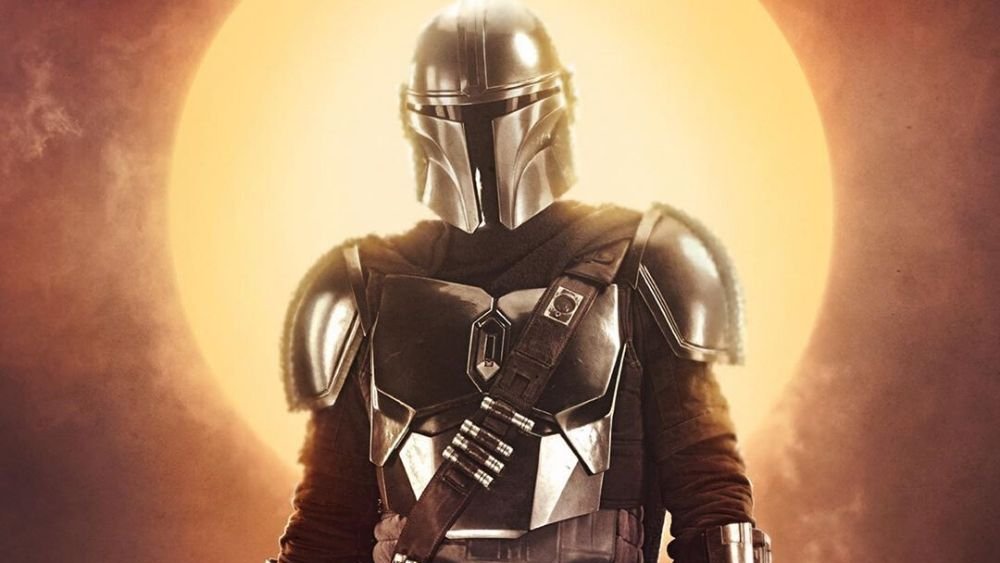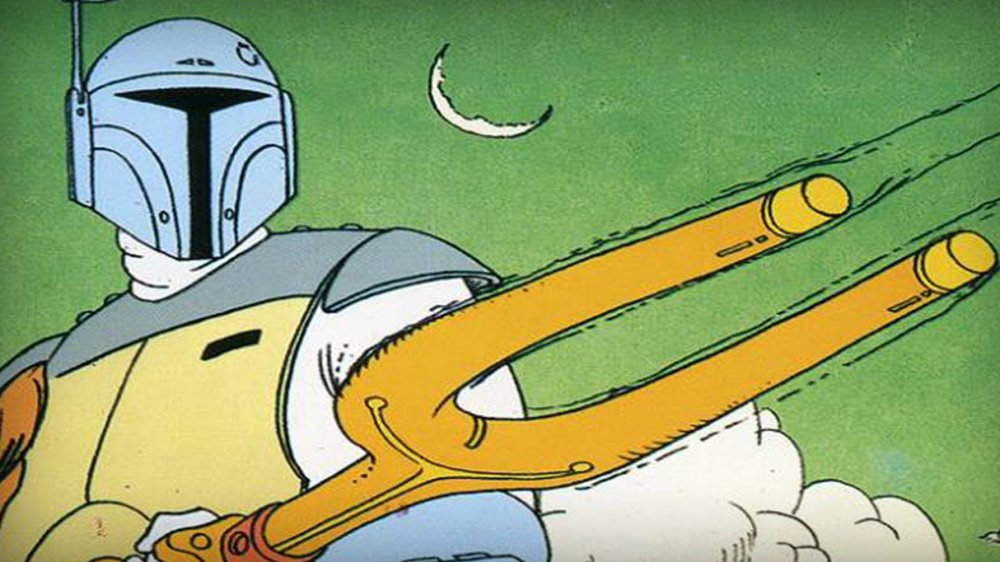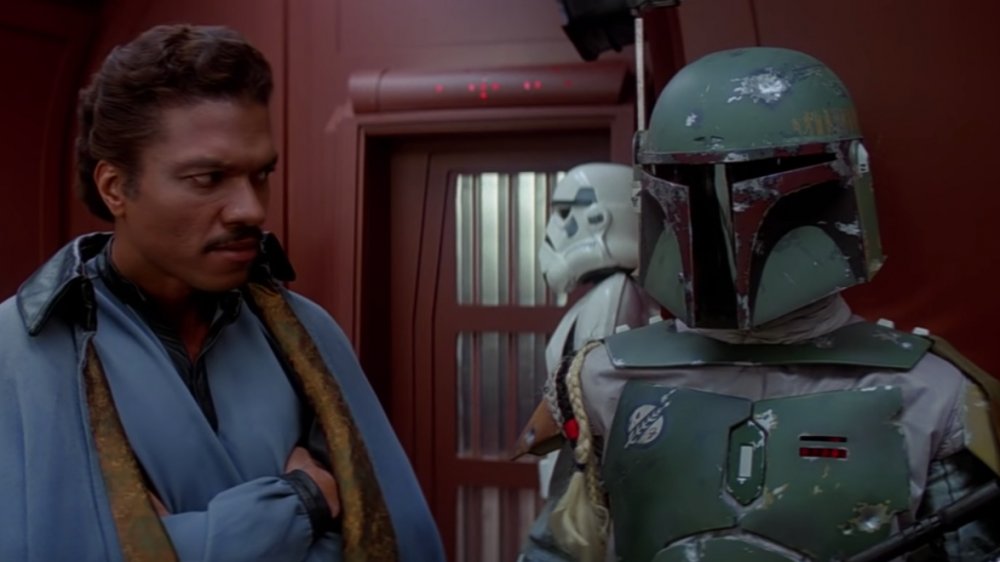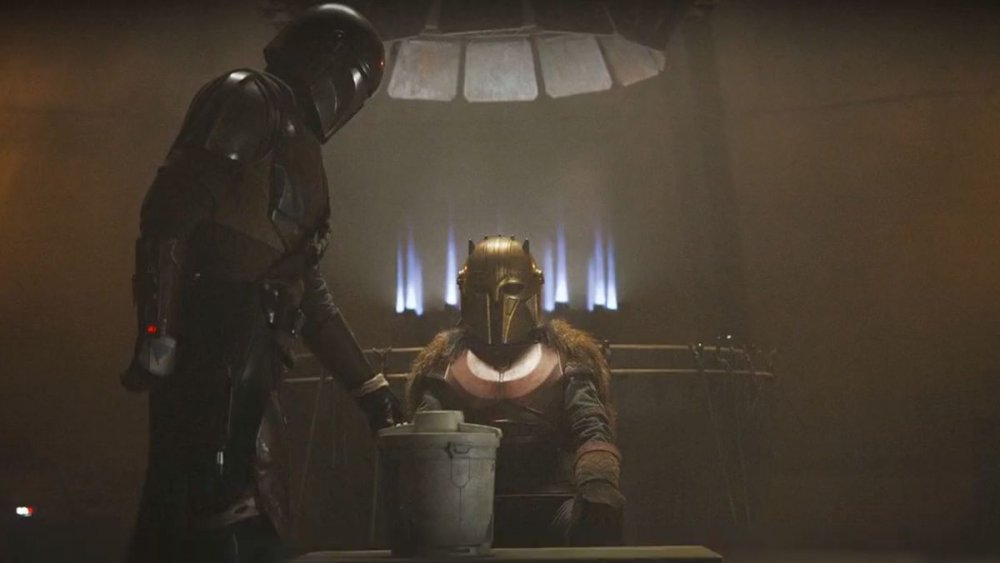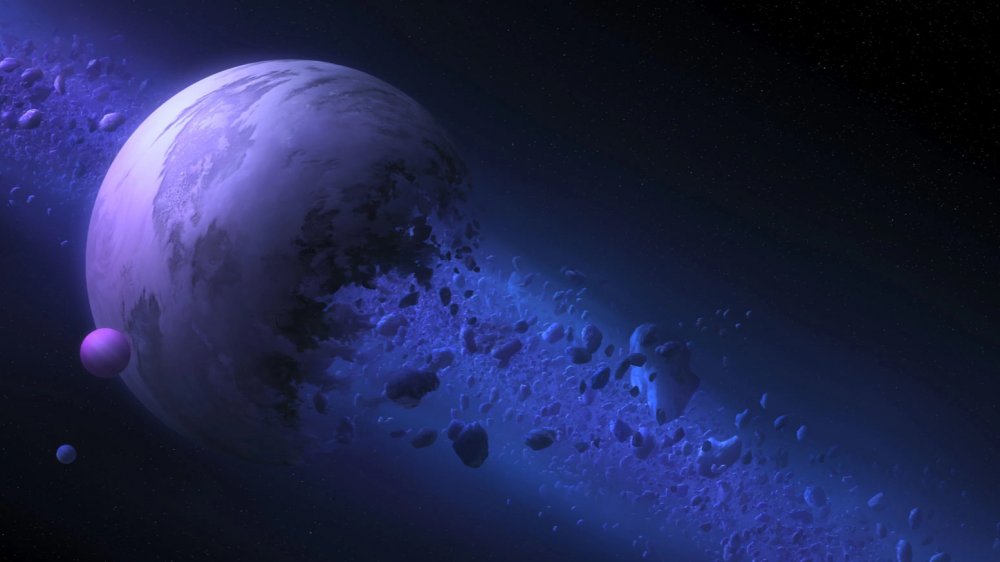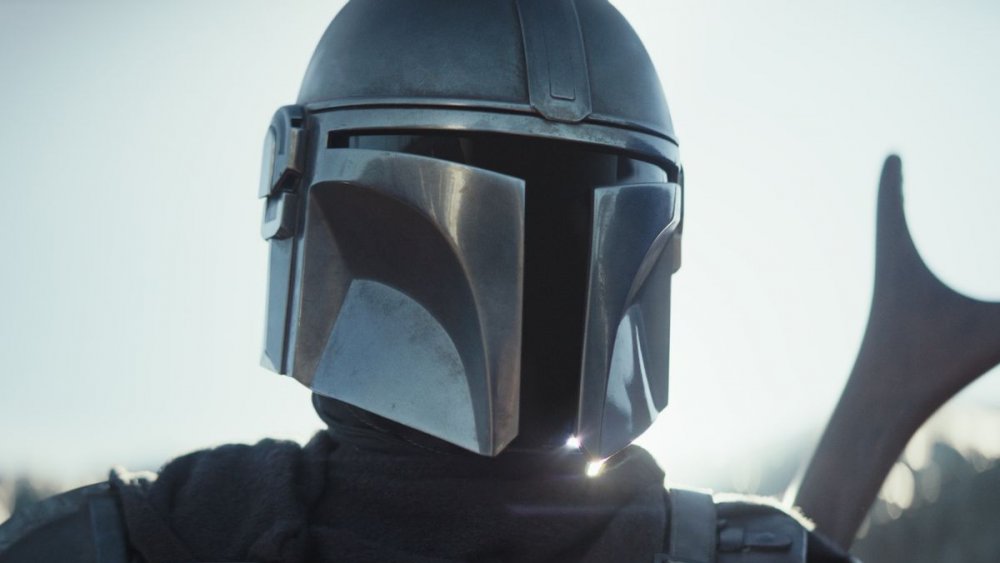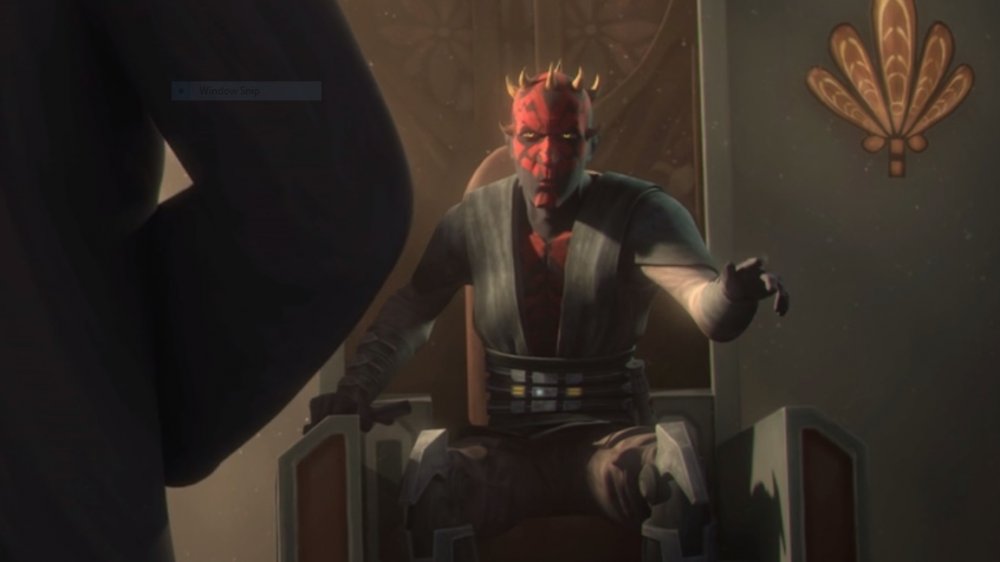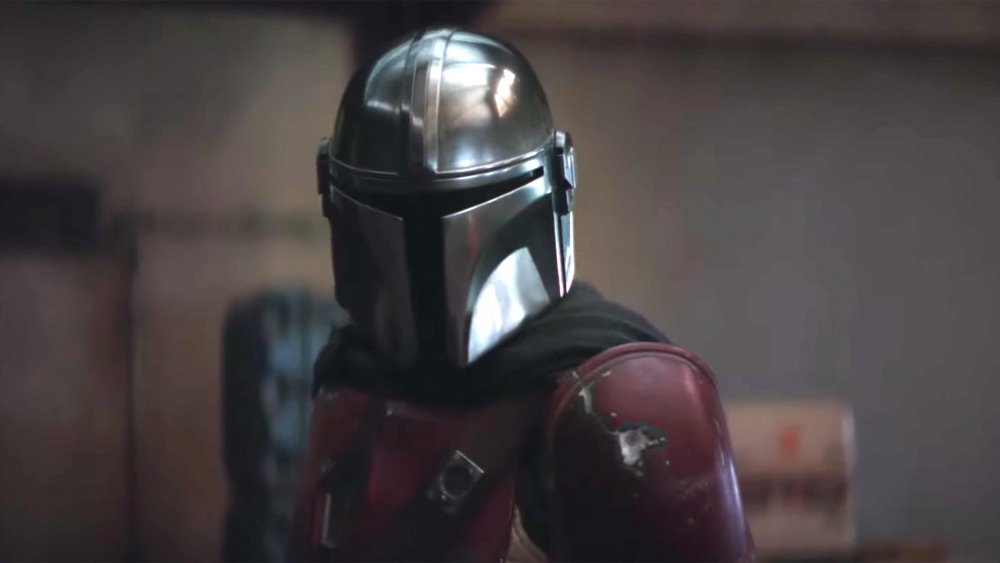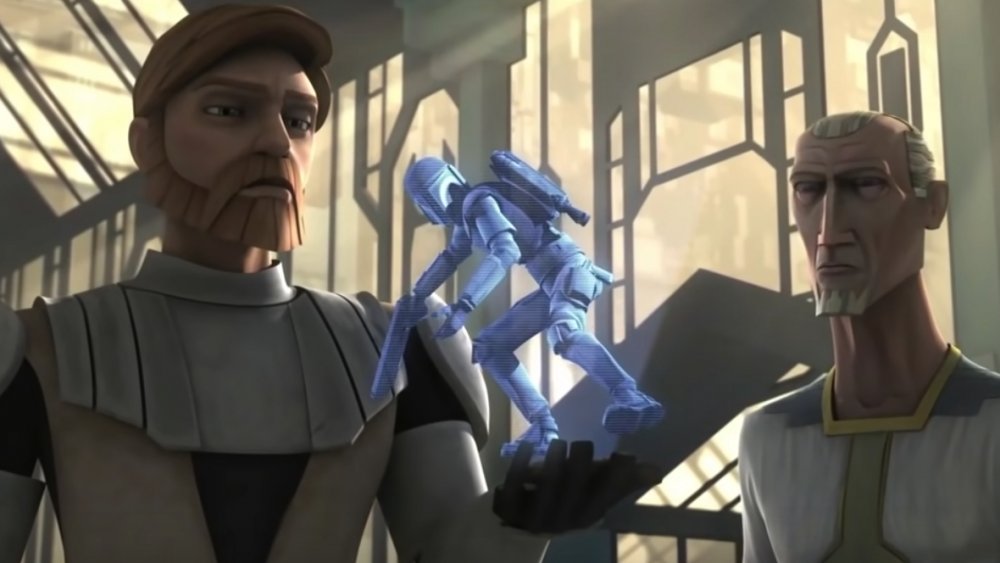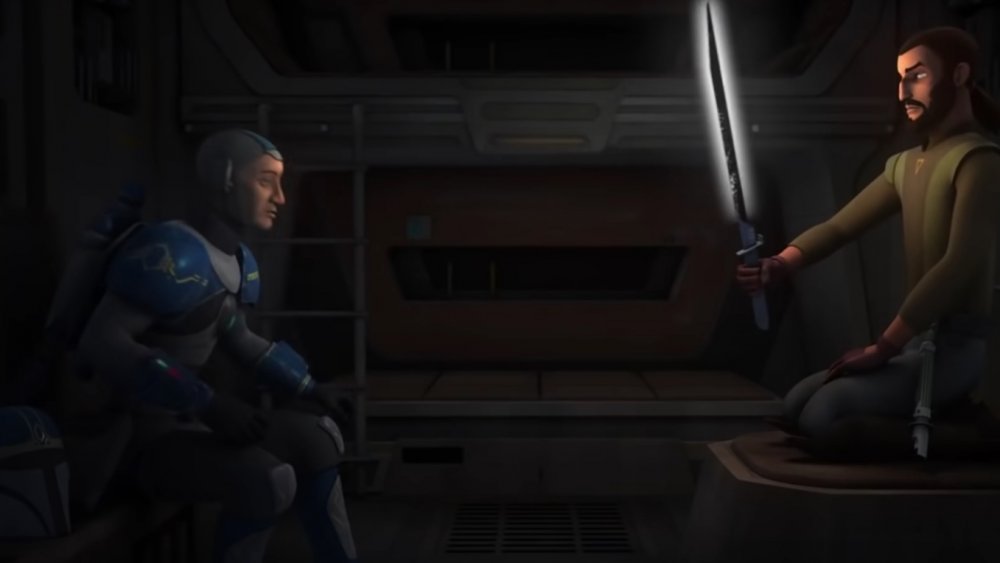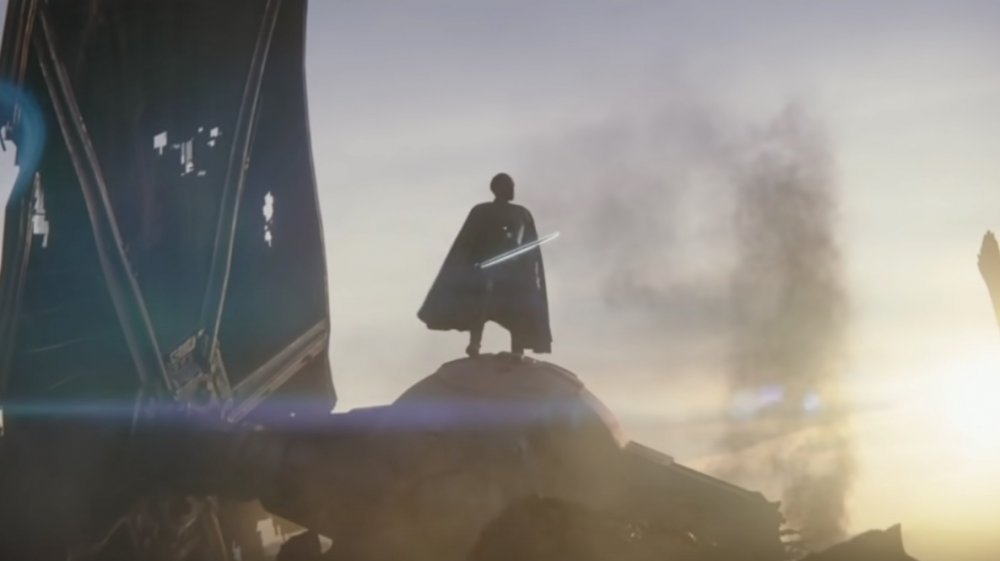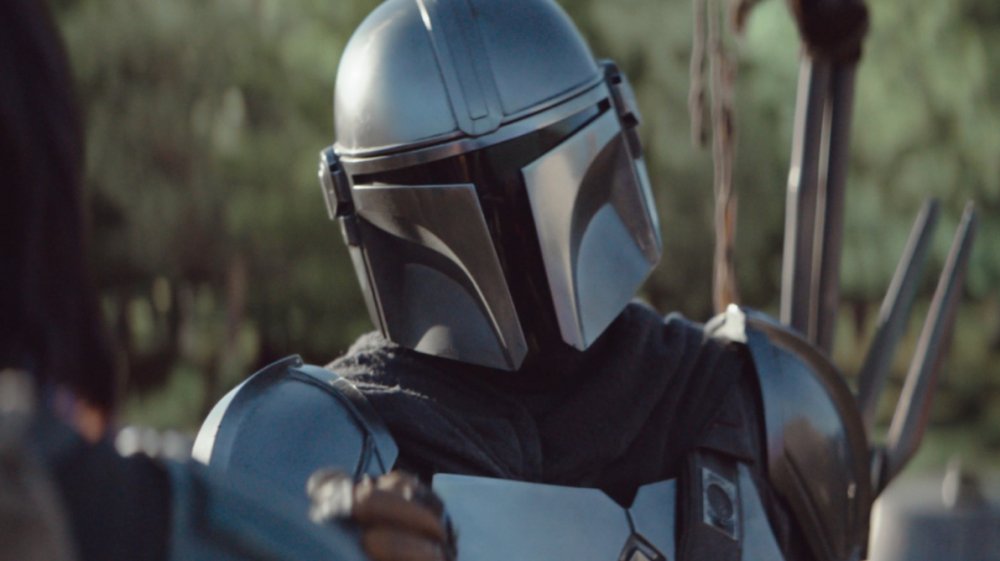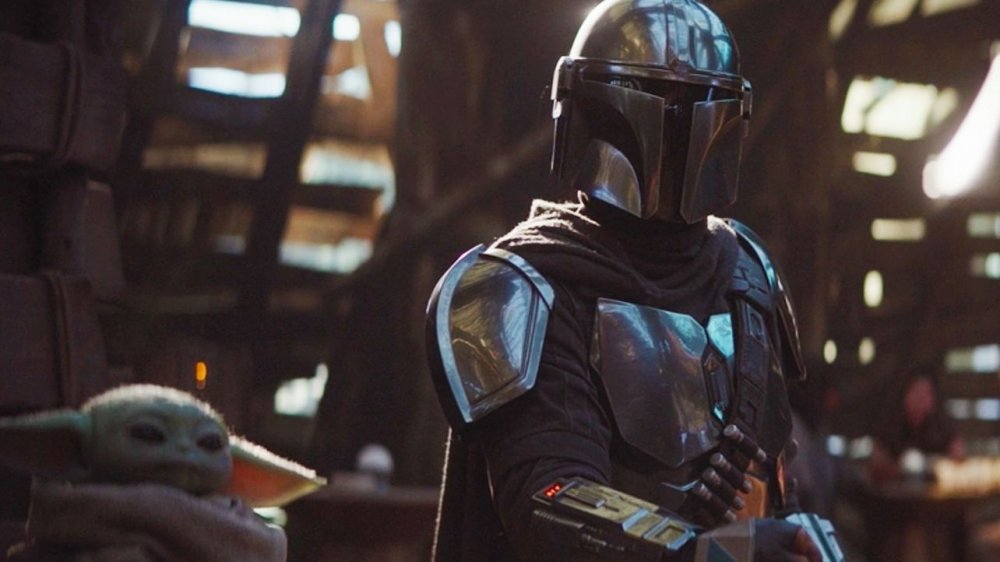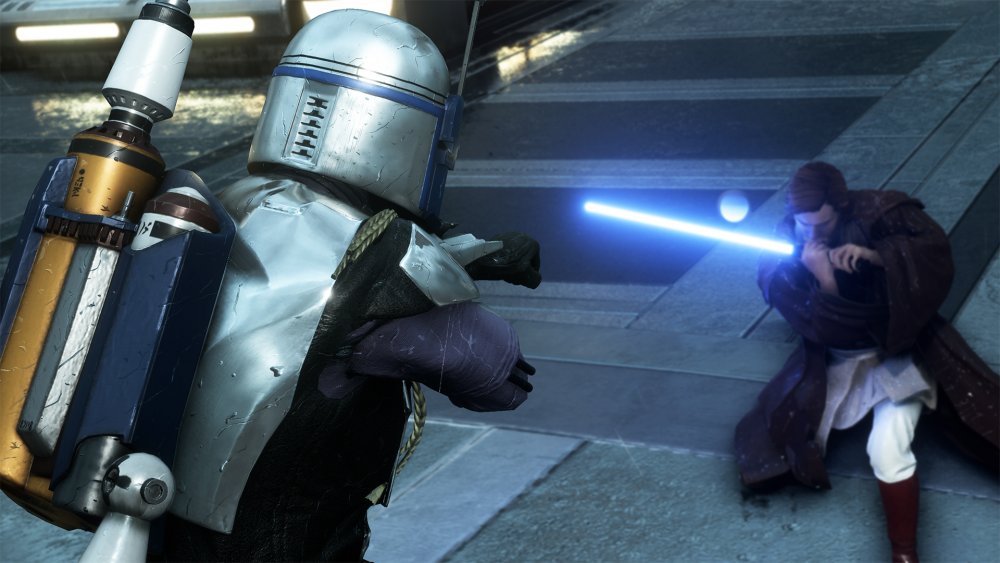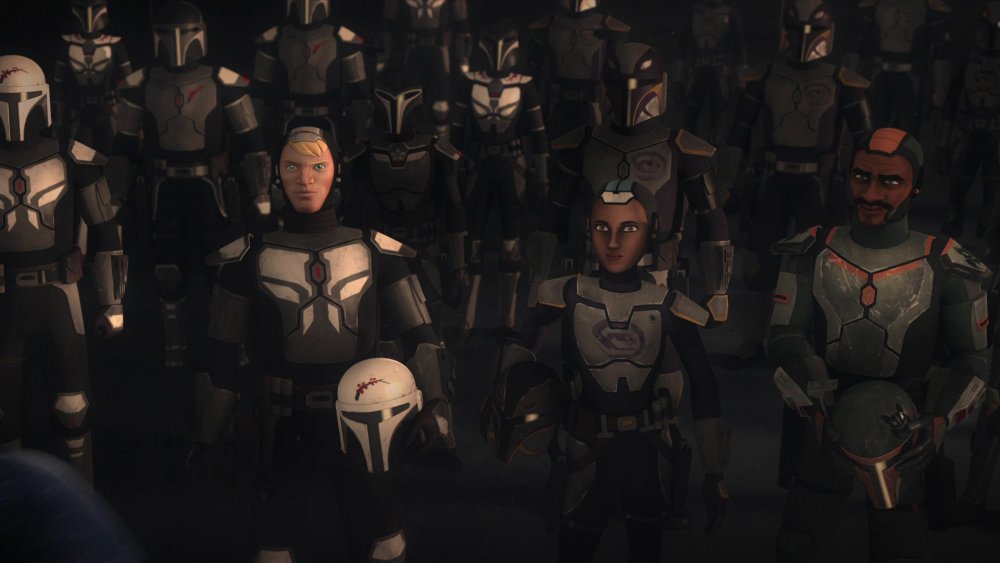The Untold Truth Of Mandalorians
Star Wars fans finally got to witness a live-action series in Disney+'s The Mandalorian. Although Baby Yoda stole fans' hearts and continues to make the perfect meme, the show's really all about the masked bounty hunter known as Mando (Pedro Pascal) — after all, it's right there in the name.
Throughout the first season, Mando shows off his fighting moves while staying true to his creed and code (and himself). After years of being known mainly to hardcore Star Wars fans, Mandalorians have finally hit the mainstream — but much of the audience knows as little about them as ever. What exactly is a Mandalorian? Can anyone be a Mandalorian? Where do Mandalorians come from? Is Boba Fett a Mandalorian? Also, where in the Star Wars timeline does The Mandalorian even take place?
The tradition and history surrounding the Mandalorians is one of the great stories of the Star Wars universe. Aside from that distinctive armor, what makes them so special? We're glad you asked — here's the untold truth of Mandalorians.
What makes a Mandalorian
Mandalorians are from the Outer Rim planet Mandalore. The planet's citizens are divided into Houses and Clans that were frequently at war with one another, despite having a common creed and code.
A person doesn't have to be born on Mandalore to be a Mandalorian, however — Mandalorians recruit orphans (known as foundlings) and teach them how to fight as well as about the Mandalorian culture, creed, and code. Mando was a foundling and was adopted into the culture — a history that led him to take pity on the alien fans dubbed "Baby Yoda" after he was tasked with its retrieval early in season one of The Mandalorian.
Although Mando is human, Mandalorians can be any type of species. What ties them together is their spoken language (Mando'a) and, as mentioned above, culture, code, and creed. Realistically, virtually anyone or thing can become part of the culture as long as they're willing to learn the way of the Mandalorian, as well as have potential on the battlefield.
Boba Fett's popularity inspired Mandalorian projects
Before the live-action series, Boba Fett was the most popular Mandalorian... yet he isn't actually a Mandalorian. As Star Wars: Episode II – Attack of the Clones makes clear, he is a clone of bounty hunter Jango Fett. While Jango taught Boba the ways of the Mandalorian (and hooked him up with that sweet Mandalorian armor), he didn't grow up surrounded by the Mandalorian culture. It might sound complicated, but showrunner Jon Favreau, director Dave Filoni, and star Pedro Pascal cleared things up in an interview with EW.
"Our guy is a Mandalorian, and we definitely explore the culture of the Mandalorian," Favreau explained.
"Boba Fett is a clone, according to Attack of the Clones, and by asking [creator George Lucas], he would say Boba Fett is not Mandalorian, not born on Mandalore," added Filoni. "He's more of a person indoctrinated into it, into the way of life, and gets a hold of the armor."
Boba Fett is also a villain — a bounty hunter truly in it only for his own personal gain — and while Mando is certainly capable of lethal violence, it remains to be seen where his moral compass really points.
Mandalorians are mostly human, but they can be any species or gender
Mandalorians are said to be mostly human, but they can be any species. And while Mando and Boba Fett are the characters most casual fans commonly associate with the culture, its members can be male or female — as evidenced by the Armorer (Emily Swallow), who enhances Mando's armor in The Mandalorian. Not only does she know how to forge with the best of them, but she's also a fearless fighter.
Mando (real name Din Djarin), Greef Karga, and Cara Dune have a telling conversation in season 1, chapter 8. After Mando points out that he wasn't born on Mandalore, Karga retorts "But you're a Mandalorian," after which Dune adds, "Mandalorian isn't a race." Mando ultimately agrees, noting, "It's a creed."
After a flashback to young Din Djarin being saved by Mandalorians, Mando explains, "I was a foundling. They raised me in the fighting corps. I was treated as one of their own. When I came of age, I was sworn to the creed."
That creed informs Mando's mission throughout season one of The Mandalorian. As the Armorer points out, while the Mandalorians were once enemies with Baby Yoda's species, Mando's responsibility for the foundling supersedes that animosity — he's responsible for his charge, no matter the cost. As Mando himself would say, "This is the way."
The Mandalorians once controlled part of the galaxy
It's mentioned in The Mandalorian that Mandalorians aren't as common as they used to be. That's an understatement. While the Empire wiped out most of the Mandalorians in an event known as the Great Purge, in their heyday the Mandalorians were some of the most feared warriors in the universe. They worked as bounty hunters and mercenaries, and were ruled over by leaders who held the title Mand'alor. Their violent tendencies drove them to conquer other worlds, including Krownest and Concord Dawn, Jango Fett's alleged homeworld.
Eventually, the Mandalorians' warlike ways attracted the attention of the Jedi, and the subsequent wars went on for centuries. They came at a great cost, too. In the final battle between the Jedi and the Mandalorians, a cataclysmic event transformed the surface of Mandalore into an inhospitable desert, forcing the Mandalorians to abandon war and focus on reconstruction. Eventually, the Mandalorians rebuilt their cities under sealed domes, which protected citizens from Mandalore's harsh environment.
A civil war followed, during which Mandalore's warrior class waged battle against the New Mandalorians, who advocated for peace. Ultimately, the New Mandalorians won, transforming Mandalore into a pacifist society. Satine Kryze took over as the Duchess of Mandalore, and the more militant factions were exiled to Concordia, one of Mandalore's moons.
The Mandalorian pyramid structure
As with all great empires, the Mandalorians had a pyramid structure with the most elite warriors at the top, followed by the less powerful. On top of the pyramid lies the Mand'alor, the leader of the Mandalorian people, guarded by the Protectors — upper echelon Mandalorian warriors who helped to maintain balance and peace among the people. Under the Protectors are the houses, which are made up of clans who battled each other over centuries for power.
While all this combat helped to make the Mandalorians some of the strongest fighters, fighting was also a big reason why the Mandalorian Empire fell from grace. Their lands were ruined, the body count stacked up, and the Mandalorians weakened over time. There's still no arguing with the results the culture initially produced — the warriors that continue the Mandalorian tradition, such as Mando, remain formidable, virtually unbeatable in one-on-one combat, and follow a strict creed.
Darth Maul was once the ruler of Mandalore
During the Clone Wars, pacifist Duchess Satine Kryze was a target for assassination attempts because of her beliefs. Obi-Wan Kenobi and other Jedi dropped their differences and came to the aid of Kryze, but their efforts fell short against the Death Watch, a terrorist group led by Concordian governor Pre Vizsla. Vizsla, who wanted to revive Mandalore's militaristic culture, teamed up with Darth Sidious' former apprentice Maul to take over the planet. Kryze was overthrown, and when the dust settled, Maul sat on the throne.
Let's go over that again. Darth Maul, who was a Sith Lord, ruled the Mandalorian Empire. Just for clarification: He wasn't not a Mandalorian. He didn't exactly live by Mandalorian traditions. He was a Sith Lord who wielded the dark side. But Mandalorians and Jedi were brutal foes for a long time, and the Sith and Jedi will always be enemies. In many ways, it makes sense.
Maul's reign didn't last, though. On the eve of Order 66, which sparked the Jedi's downfall and marked the transformation of the Galactic Republic into the Empire, former Padawan Ahsoka Tano and some loyal clones traveled to Mandalore to stop Maul and free the planet. The ensuing battle, known as The Siege of Mandalore, ousted Maul and inadvertently paved the way for Imperial occupation of the planet.
Mandalorian armor can repel a lightsaber
Mandalorian armor is obviously one of the biggest reasons why Mandalorians look so cool, although their moves on the battlefield earn them a lot of extra style points.
Made out of a rare substance called Beskar, also known as Mandalorian steel, it's strong enough to repel a lightsaber and can withstand a blaster shot. It's one of the strongest alloys in the galaxy. The armor's insignias also reflected clan affiliation and paid tribute to the legacies of fallen warriors of the past. But because bad guys always find a way to ruin a good thing, a superweapon called the Arc Pulse Generator was created that could burn Mandalorian steel to a crisp. (The Arc Pulse Generator was, ironically, created by a Mandalorian but used by the Galactic Empire.)
Everyone has a kryptonite, even warriors who fight better than everyone else and are protected by legendary metal that's, well, better and stronger than everything else.
Mandalorians and Jedi didn't always see eye to eye
Mandalorian armor's ability to withstand a lightsaber came in handy on more than one occasion. While Obi-Wan Kenobi and other Jedi stepped in to help save Kryze's Mandalore, Mandalorians and Jedi were once fierce enemies.
The Mandalorian's warmongering ways didn't sit well with the Jedi. Despite not having the ability to use the Force or obliterate enemies with lightsabers, strong Mandalorian warriors could go toe to toe with Jedi Knights.
Their differences, of course, didn't last forever. Jedi tend to be reasonable and moral beings. They take the high road and make decisions to help the greater good. Their code calls for peace, despite being masterful in combat. Mando, whether or not he thinks the Force is a myth, helps Baby Yoda even though Baby Yoda shows the ability to use the Force. Circumstances have changed for Mandalorians and Jedi alike quite a bit in The Mandalorian's era of Star Wars.
Tarre Vizsla was the first Mandalorian to join the Jedi Order
It's hard to imagine the Mandalorians and Jedi on the same team, as battles between the two caused devastating destruction to Mandalore. Given their rigid differences, it's just as hard to fathom a Mandalorian Jedi — but there's an exception to every rule.
Tarre Vizsla was the first Mandalorian to be inducted into the Jedi Order, with his connection to the Force playing a role. While joining the Jedi Order at a young age, he eventually became the Mand'alor of his planet, fitting for a person of his capabilities. "Mandalorian Jedi" is quite the title on a business card — and every fearsome warrior in the Star Wars universe deserves a distinctive weapon.
Vizsla, being part of two respected orders and oozing with potential, built his own version of a lightsaber, dubbed the darksaber. It might sound like it'd be completely against everything the Jedi stand for, but it was perfect for Vizsla — and it ended up meaning quite a bit to the Mandalorians.
The tale of the Darksaber
The darksaber, a unique black-colored lightsaber, became the symbol of House Vizsla. It was the perfect weapon for an individual who was a Mandalorian yet part of the Jedi Order. After Vizsla's passing, the darksaber was kept in the Jedi Temple; eventually, House Vizsla members took the black-bladed saber back and it was used to unite the people of Mandalore.
The darksaber was passed down, generation to generation, and it eventually made it into the hands of Darth Maul. The saber continued to make its rounds, from good to evil, eventually falling to Moff Gideon, who's seen with the darksaber in The Mandalorian's season 1 finale. The darksaber's powers were put on display when Gideon carved through his ruined TIE fighter like butter, escaping the wreckage untouched and ready to conquer and standing on top of it, darksaber in hand. What better way to introduce a weapon of the darksaber's lore and magnitude in the first Star Wars live-action series?
Mandalorians fancy board games and art
Mandalorians are known for their fighting, but they still know how to have fun — in fact, they have their own board game. It's called Cubikahd and it's played using holograms (as if there's any other way in the high-tech Star Wars universe). The game is played with four hologram knives per person and the goal is to catch the other person's pieces.
On top of being masters of the board game, Mandalorians also fancy art and are rich in artistic culture, which just goes to show you that work-life balance on any planet, no matter how violent, is important. Mandalorian art extended to their own art movement called Mandalorian cubism, which was popular during the Clone Wars between the Galactic Republic and the Confederacy of Independent Systems. Board games and art — underneath that imposing armor, Mandalorians are people too.
There's a Mandalorian reason why Mando has a soft spot for Baby Yoda
Although pairing Mando with Baby Yoda in The Mandalorian is pure TV-writing genius, there's a Mandalorian reason why Mando has a soft spot for Baby Yoda. As previously discussed, Mandalorians have a soft spot for orphans, and Mando himself became an orphan when his parents were killed.
Since history tends to repeat itself (or at least carries similar meanings across time), Mando rescued Baby Yoda, who's presumably an orphan. It doesn't hurt that Mando has seen Baby Yoda's Force capabilities firsthand, as Mandalorians are particularly prone to taking in orphans who show the power and a willingness to fight, which could be a small reason why Mando goes back for Baby Yoda in chapter 3.
Baby Yoda is now Mando's foundling. The cool thing is that both uber-powerful creatures look after one another, saving each other's lives on the regular, which will hopefully become a theme in future seasons.
Many of the Mandalorians' signature gadgets were designed to kill Jedi
Lightsaber-deflecting Beskar steel isn't the only weapon the Mandalorians developed to stymie their Jedi opponents. In fact, many of the weapons often associated with Mandalorians were developed specifically to fight their Force-powered foes, while the Mandalorians' unique fighting style evolved during their clashes with the Jedi in an effort to give them the upper hand.
As Dave Filoni, executive producer of Star Wars: The Clone Wars, Star Wars Rebels, and The Mandalorian and George Lucas' hand-picked padawan, explains, "Their weapons, their arsenal, their technology had a massive increase once they collided with the Jedi and found these Force-wielding people that had abilities they didn't understand."
Filoni didn't just make that up, either. "I've always believed that because that seemed to be something that would be in the DNA of the Joe Johnston designs of them as super commandos," Filoni says, referring to the legendary Star Wars concept artist who created Boba Fett's iconic look.
At any rate, it seems to have worked. Just look at how much trouble Obi-Wan Kenobi has beating Jango Fett in Attack of the Clones, or dealing with the members of Death Watch in The Clone Wars. Now imagine a whole army of Mandalorians in their prime. It's amazing that the Jedi ever stood a chance.
The Mandalorian language is more real than you might think
While most Mandalorians speak Basic, the universal dialect that links the Star Wars universe together, they actually have their own language. It's called Mando'a, and while it's not quite as well developed as J. R. R. Tolkien's elvish tongues or Star Trek's Klingon, both of which you can actually speak with enough practice, it's much more fully developed than you probably realize.
Mando'a first appeared in Attack of the Clones, albeit only in written form, and went on to pop up in both Star Wars: The Clone Wars and Star Wars Rebels (it's actually spoken out loud in the Rebels episode "Legacy of Mandalore," which is obviously all about Mandalorians). However, the language really started to take shape in the video game Star Wars: Republic Commando, which features an old Mandalorian war chant called "Vode An," which translates to "Brothers All."
From there, author Karen Traviss picked up the reins. Her novel Republic Commando: Hard Contact includes an extensive Mando'a glossary, as well as grammatical factoids like the idea that Mando'a is only spoken in the present tense — Mandalorians believe in a "living history," as the explanation goes — and that it's gender-neutral.
Unfortunately, Hard Contact is no longer canon, and Traviss has removed all of the supplemental information about Mondo'a from her website. Still, a handful of Mando'a words can be found in Fantasy Flight Games' tabletop RPG supplement, Collapse of the Republic and other tie-in material, including the official Star Wars: Galaxy's Edge cookbook, if you're looking to get educated.
